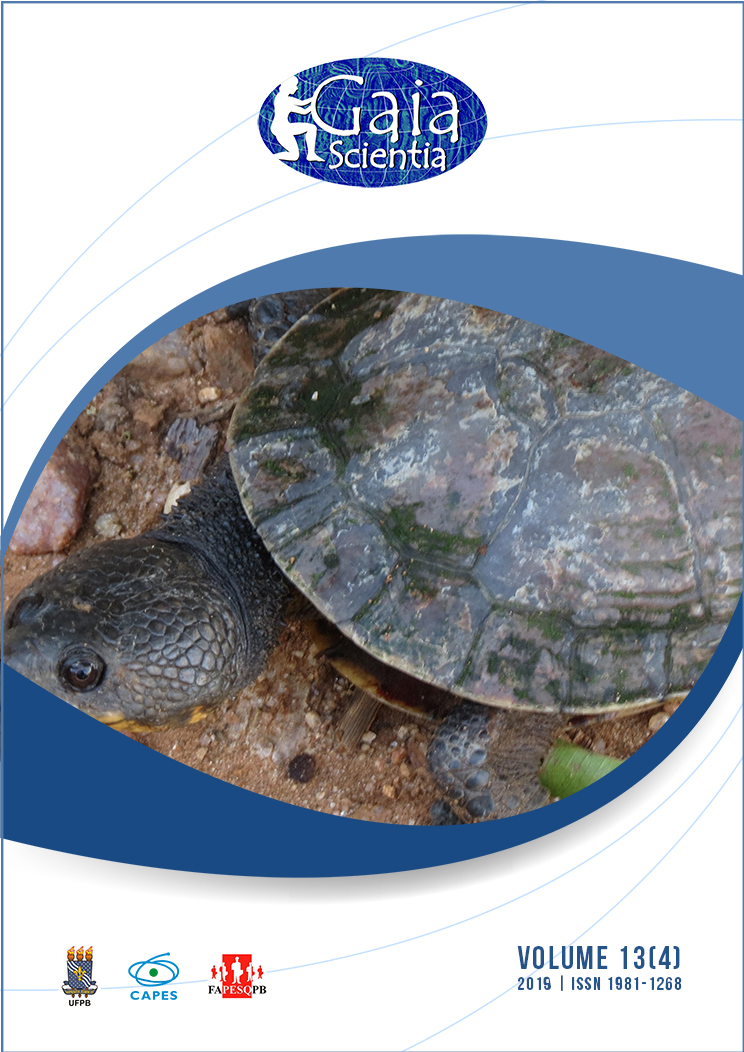Exageneous intoxications in Alagoas, Brazil: pesticides emphasis
DOI:
https://doi.org/10.22478/ufpb.1981-1268.2019v13n4.44460Abstract
In order to describe the cases of exogenous intoxication in the State of Alagoas, with emphasis on pesticides, a survey was conducted between the period 2007 and 2017, from the SINAN database, provided by the Alagoas State Health Department. They were recorded total of 28,314 cases of exogenous intoxication, wherein medicines (33.9%), food and beverages (11.3%) and pesticides (8.8%) were the main intoxicating agents. The year 2013, with 4,489 notifications, was those with the highest number of records. In relation to pesticides, 1,151 cases were reported, wherein the city of Arapiraca, with 246 records, led the ranking of notifications. Male population (73.7%), aged between 20 and 49 years (60.7%), with a low educational level (21.6%), who became intoxicated at their residence (39.7%), in sprayings (20.8%) of herbicide (28.5%), mainly 2,4D (60.8%), were the main circumstances. It was detected that 90% of the aggravations by pesticides presented cure without sequels, despite the registry of 28 deaths. This information shows that exogenous poisoning is a public health issue and that monitoring of records and on-site monitoring by health workers, investments in rural extension work, and technical assistance could significantly reduce the problem.
Downloads
References
ABIFINA (Brazilian Association of the Industries of Fine Chemistry, Biotechnology and its Specialties). 2017. Situação atual e perspectivas da indústria de defensivos agrícolas nacional. Available at: <http://www.abifina.org.br/revista_facto_materia.php?id=655>. Accessed on: 31 Jan. 2019.
AGRICULTURA (Agriculture, Livestock and Supply). 2018. Agropecuária cresceu 13% em 2017. Available at: <http://www.agricultura.gov.br/noticias/agropecuaria-cresceu-13-em-2017>. Accessed on: 31 Jan. 2019.
Barboza IO, Pinto LCT and Pessoa SRN. 2016. Estudo sobre a agricultura familiar em Alagoas. Maceió: SEPLAG, 56 p.
Bombardi LM. 2017. Geografia do uso de agrotóxicos no Brasil e conexões com a União Europeia. São Paulo: FFLCH/USP, 296 p.
Carvalho FSA, Mororó WMD, Alencar YCA, Sette RBT and Souza MNA. 2017. Intoxicação exógena no estado de Minas Gerais, Brasil. Revista Ciência e desenvolvimento, 10(1):172-184.
DATASUS (Information Technology at SUS Service). 2019. Intoxicação exógena: notificações registradas no SINAN NET – Brasil. Available at: <http://tabnet.datasus.gov.br/cgi/tabcgi.exe?sinannet/cnv/Intoxbr.def>. Accessed on: 09 Jan. 2019.
Gomes AV, Cardoso PKB, Rocha FCV, Carvalho CMS, Sales MCV. 2018. Perfil sociodemográfico de idosos vítimas de suicídio em um Estado do Nordeste do Brasil. Revista Baiana de Enfermagem, 32(1):1-9. DOI: http://dx.doi.org/10.18471/rbe.v32.26078.
Hiran S, Kumar S. 2017. 2,4-D Dichlorophenoxyacetic acid poisoning: case report and literature review. Asia Pacific Journal of Medical Toxicology, 6(1):29-33. DOI: 10.22038/apjmt.2017.8475.
IBGE (Brazilian Institute for Geography and Statistic). 2019a. Censo Agropecuário. Available at: <https://www.ibge.gov.br/estatisticas-novoportal/economicas/agricultura-e-pecuaria.html>. Accessed on: 07 Jan. 2019a.
IBGE (Brazilian Institute for Geography and Statistic). 2019b. Censo Agro 2017: Resultados preliminares. Available At: <https://censos.ibge.gov.br/agro/2017/templates/censo_agro/resultadosagro/index.html>. Accessed on: 09 Jan. 2019b.
Islam F, Wang J, Farooq MA, Khan MSS, Xu L, Zhu J, Zhao M, Muños S, Li QX, Zhou W. 2017. Potential impact of the herbicide 2,4-dichlorophenoxyacetic acid on human and ecosystems. Environment International, 111(1):332-351. DOI: 10.1016/j.envint.2017.10.020.
Liberato AA, Silva LF, Lobo PHP, Dias FCF, Guedes VR. 2017. Intoxicações exógenas na região Norte: atualização clínica e epidemiológica. Revista de Patologia do Tocantins, 4(2): 1-64. DOI: 10.20873/uft.2446-6492.2017v4n2p61.
Mattei L. 2015. Emprego agrícola: cenários e tendências. Estudos Avançados, 29(85):35-52. DOI: 10.1590/S0103-40142015008500004.
Oliveira FFS, Suchara EA. 2014. Epidemiological profile of exogenous poisoning in children and adolescents from a municipality in the state of Mato Grosso. Revista Paulista de Pediatria, 32(4):299-305. DOI: 10.1590/S0103-05822014000400004.
Pignati WA, Lima FANS, Lara SS, Correa MLM, Babosa JR, Leão LHC, Pignati MG. 2017. Distribuição espacial do uso de agrotóxicos no Brasil: uma ferramenta para a vigilância em saúde. Ciência & Saúde Coletiva, 22(10):3281-3293. DOI: 10.1590/1413-812320172210.17742017.
Silva HCG, Costa JB. 2018. Intoxicação exógena: casos no estado de Santa Catarina no período de 2011 a 2015. Arquivos Catarinenses de Medicina, 47(3):2-15.
SINC (Superintendence of Information and Knowledge Production). 2016. Produto interno bruto de Alagoas (PIB) para o ano de 2014. Notas Técnicas, 1(49). Disponível em: . Acesso em: 08 Jan. 2019.
SINDUSFARMA (Industry Syndicate of Pharmaceutical Products in the State of São Paulo). 2018. Pharmaceutical industry profile. Available at: <http://sindusfarma.org.br/arquivos/Perfil-IF2018.pdf>. Accessed on: 31 Jan. 2019.
Souza CDF, Costa KF, Ramos LS. 2016. Distribuição espacial das intoxicações exógenas por agrotóxicos em trabalhadores rurais no estado da Bahia-Brasil, de 2007 a 2011. Hygeia, 12(23):133-141.
Vieira DM, Carvalho C. 2016. Perfil das intoxicações medicamentosas no Estado de São Paulo na perspectiva da vigilância sanitária. Revista Saúde e Desenvolvimento, 9(5):119-143.
Walters J. 2011. Environmental fate of 2,4-Dichlorophenoxyacetic acid. California/USA: Department of Pesticide Regulation. Available at: <https://www.cdpr.ca.gov/docs/emon/pubs/fatememo/24-d.pdf>. Accessed on: 08 Jan. 2019.
Zambolim CM, Oliveira TP, Hoffmann NA, Vilela CEB, Neves D, Anjos FR, Soares LM, Tibúrzio LS, Cardoso LAF, Murad MB, Magalhães MG, Oppermann PER, Guimarães SJ. 2008. Perfil das intoxicações exógenas em um hospital universitário. Revista Médica de Minas Gerais, 18(1):5-10.










